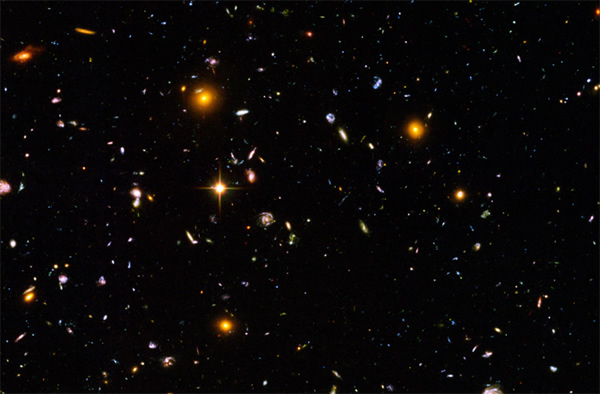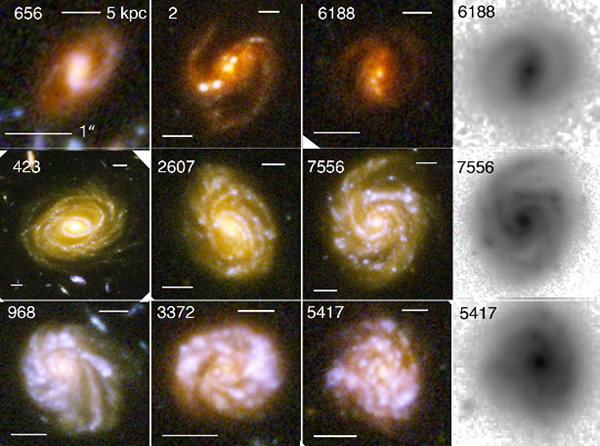When Did Galaxies Get Their Spirals?
The Hubble Ultra Deep Field, is an image of a small region of space in the constellation Fornax, composited from Hubble Space Telescope data accumulated over a period from Sept. 3, 2003 through Jan. 16, 2004. The patch of sky in which the galaxies reside was chosen because it had a low density of bright stars in the near-field.
Look in any given point in the sky and you will see galaxies. Billions and billions and billions of galaxies. Look closer and you’ll find they can be categorized into three main types of galaxy, based on their apparent shape: elliptical, spiral, and irregular. But what makes a spiral galaxy, well, spiral? And how long does it take them to get in a spin?
In a fascinating study to be published in the Astrophysical Journal, married astronomer team Debra Elmegreen (of Vassar College in Poughkeepsie, New York) and Bruce Elmegreen (at IBM’s T.J. Watson Research Center in Yorktown Heights, New York) looked to the famous Hubble Ultra-Deep Field (UDF) observation of a tiny, ‘empty’ patch of sky in the constellation Fornax. The observation gathered data from September 2003 to January 2004, capturing light that was generated right at the dawn of the Universe.
The ground-shaking revelation to come from the UDF is that even a tiny region of the sky that appears to be empty is actually stuffed full of faint, distant galaxies and in this particular observation, around 10,000 galaxies can be seen.
After some intense scrutiny, the researchers were able to pick out 269 spiral galaxies in the UDF, but whittled that number down to 41 — the others were discarded due to the lack of red-shift data (a metric that would reveal the galaxy’s distance and therefore its age) or the inability to clearly see a spiral pattern.
But of those 41 galaxies, the Elmegreens were able to sub-divide them into five morphological classifications — from the clumpy-armed spirals that had a “wooly” appearance and two symmetrical spiral arm galaxies (designated “Grand Design” galaxies) to more mature, multi-armed spiral structures, not too dissimilar to our galaxy. The different classifications painted a picture of spiral galaxy evolution and has now given astronomers a very privileged look into when the spirals of a galaxy formed in the early Universe.
Three of the five galactic morphologies studied in this research: grand design (top row), normal multiple arm and woolly. There are three examples of each (in color) and an H-band image of the right-most example in black and white.
Elmegreen and Elmegreen
“The onset of spiral structure in galaxies appears to occur between redshifts 1.4 and 1.8 when disks have developed a cool stellar component, rotation dominates over turbulent motions in the gas, and massive clumps become less frequent,” write the astronomers.
The redshift of a galaxy directly relates to that galaxy’s age. As the Universe expands, ancient light traveling through the universe will get stretched. This ‘light-stretching’ is known as redshift. The higher the redshift, the further the light has traveled, so the older it is.
Therefore, from the redshift measurements of this small collection of galaxies in the UDF, the researchers have found that a definite spiral galaxy structure begins to form for galaxies at redshift 1.8, which equates to approximately 3.7 billion years after the Big Bang. However, these are only the embryos of spiral galaxies, the “woolly”-type galaxies with very basic structures smeared with nebulous clouds of star formation. It’s not until approximately 8 billion years after the Big Bang (redshift 0.6) that more complex, multi-arm spiral structures form.
“The observations of different spiral types are consistent with the interpretation that clumpy disks form first and then transition to spirals as the accretion rate and gas velocity dispersion decrease, and the growing population of old fast-moving stars begins to dominate the disk mass,” they write.
In a nutshell, early galaxies are a turbulent mess of gas, dust and voracious star formation. These tumultuous times are not conducive to the galaxy settling into a more refined spiral structure. But given enough time, older stars begin to dominate the galactic landscape as the once-giant star formation regions shrink. These factors limit the instabilities throughout the galaxy, heralding a long, quiescent spiral galaxy structure not too dissimilar to the Milky Way’s shape some 13.75 billion years after the Big Bang.
As pointed out by The Physics arXiv Blog, although this research goes a long way to describe the evolution of galaxies in the earlier phases of the Universe, it would be interesting to see how dark matter factors in. Dark matter is known to pervade the known Universe and has been linked with galaxy growth. Also, how do the supermassive black holes, known to lurk in the centers of the majority of galaxies, factor into the evolution of spiral galaxies?
This study highlights the incredible power of the Hubble Space Telescope and proves that the data it provides continues to transform how we view the Cosmos.(Dec 30, 2013 02:13 PM ET // by Ian O'Neill)













